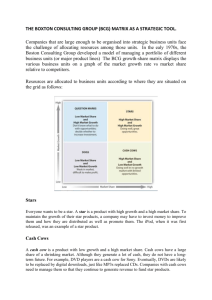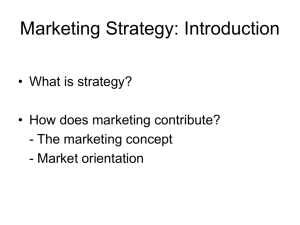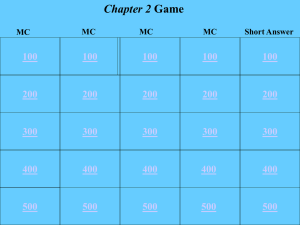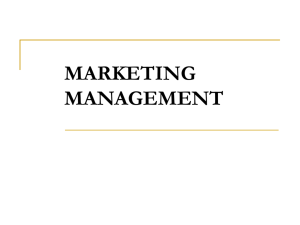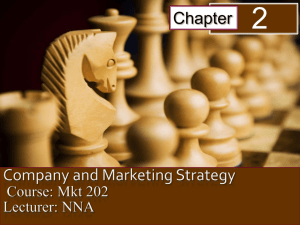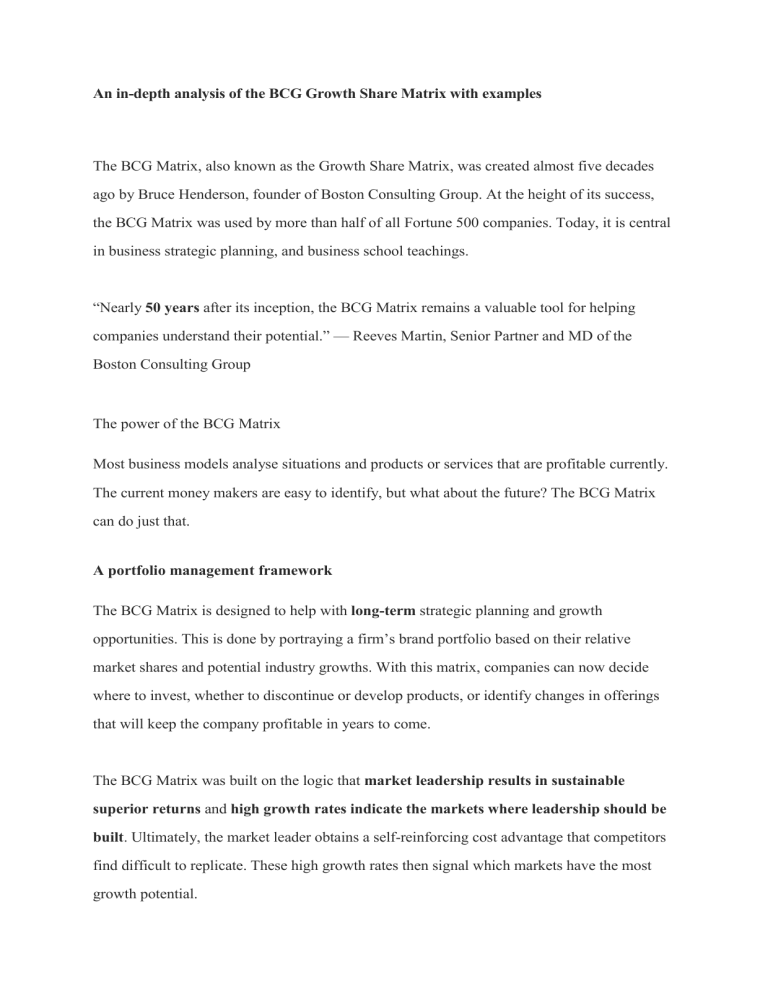
An in-depth analysis of the BCG Growth Share Matrix with examples The BCG Matrix, also known as the Growth Share Matrix, was created almost five decades ago by Bruce Henderson, founder of Boston Consulting Group. At the height of its success, the BCG Matrix was used by more than half of all Fortune 500 companies. Today, it is central in business strategic planning, and business school teachings. “Nearly 50 years after its inception, the BCG Matrix remains a valuable tool for helping companies understand their potential.” — Reeves Martin, Senior Partner and MD of the Boston Consulting Group The power of the BCG Matrix Most business models analyse situations and products or services that are profitable currently. The current money makers are easy to identify, but what about the future? The BCG Matrix can do just that. A portfolio management framework The BCG Matrix is designed to help with long-term strategic planning and growth opportunities. This is done by portraying a firm’s brand portfolio based on their relative market shares and potential industry growths. With this matrix, companies can now decide where to invest, whether to discontinue or develop products, or identify changes in offerings that will keep the company profitable in years to come. The BCG Matrix was built on the logic that market leadership results in sustainable superior returns and high growth rates indicate the markets where leadership should be built. Ultimately, the market leader obtains a self-reinforcing cost advantage that competitors find difficult to replicate. These high growth rates then signal which markets have the most growth potential. Creating your BCG Matrix The matrix reveals two factors that companies should consider when deciding where to invest — company competitiveness, and market attractiveness — with relative market share and growth rate as the underlying drivers of these factors. These two dimensions make up the axes of the matrix. Understanding the tool The relative market share indicates incremental cash generation. Typically, units with a higher relative market share churns out higher profits and return on investments due to higher economies of scale. Meanwhile, Relative Market Growth indicates cash usage. A greater relative market growth rate means higher earnings (and sometimes profits) but it also consumes lots of cash, which can be used as investment to stimulate further growth. Invest in the ‘Stars’ The business units that make up a sizeable portion of the market and generate the most cash are considered ‘Stars’. Stars tend to consume large amounts of cash, as they require high funding to fight competitors and maintain their growth rate. This generally results in the same amount of money coming in that is going out. If a Star can remain a market leader, it eventually becomes a Cash Cow when market growth slows, providing positive cash flows. Yet, not all Stars become Cash Cows. This is especially true in rapidly changing industries, where new innovative products can soon be outcompeted by new technological advancements, so instead of becoming a Cash Cow, a Star might become a Dog. Potential Strategies Vertical integration, horizontal integration, market penetration, market development, product development Facebook’s Star — Instagram Besides its high market share, Instagram is also currently the highest growing SBU owned by Facebook, and has doubled its user base to 700 million monthly active users in two years. This is largely due to Instagram’s features ‘Direct’ and ‘Stories’. By sticking to its roots of visual communication while shrewdly adapting to new trends by investing in product development, Instagram has managed to stay on top of the game. Choose to invest in, or discard ‘Question Marks’ Question Marks hold low market share in fast growing markets, consuming large amounts of cash, and incurring losses. As the name suggests, it’s not known if they will become a Star or drop into the Dog quadrant. Question Marks have the potential to gain market share and become Stars, and eventually Cash Cows when market growth slows. On the flip side, even after large amounts of investments, question marks may still not succeed in becoming a market leader, thus eventually turning into Dogs. Therefore, the units in the Question Mark quadrant require very close consideration to decide if they are worth investing in or not. Companies are advised to invest in Question Marks if the product has the potential for growth, or to sell if it does not. Potential Strategies Market penetration, market development, product development, divestiture Facebook’s Question Mark — Oculus Oculus specializes in virtual reality (VR) hardware and software products. Large investments are required in research & development efforts, yet there is no certainty that Oculus will be successful and if people have a desire for VR. NYTimes reports Zuckerberg’s plans to invest $3 billion over the next decade to bring VR to millions of users, signaling Facebook’s intentions to turn Oculus into a Star. Milk ‘Cash Cows’ for cash to reinvest Cash Cows are the leaders in the marketplace and generate more cash than they consume. These business units have a high market share in a slow-growing industry. They are regarded as staid and boring, in a “mature” market, yet corporations value owning them due to their cash-generating qualities. Companies are advised to invest in Cash Cows to maintain the current level of productivity, or to “milk” the gains passively. The cash gained from Cows should be invested into Stars and Question Marks to support their further growth, while supporting the Cash Cows to maintain their current market share. “Cash Cows provide the cash required to turn question marks into market leaders, cover the administrative costs of the company, fund research and development, service the corporate debt, and pay dividends to shareholders.” Potential Strategies Product development, diversification, divestiture, retrenchment Facebook’s Cash Cow — Whatsapp Whatsapp’s growth rate has been more or less maximised, with few competitors. Investments in Whatsapp is hence deemed unnecessary. Their market share however, is very high, making Whatsapp a money generating Cash Cow. Liquidate, divest or reposition ‘Dogs’ Dogs are units with low market share in a mature, slow-growing industry. These units typically “break even”, generating barely enough cash to maintain the business’s market share, and depress a profitable company’s return on assets ratio. Because of this, Dogs can turn out to be cash traps, tying up company funds for long periods of time. For this reason, they are prime candidates for divestiture. Dogs should be divested once short-time harvesting has been maximised. The usual marketing advice here is to aim to remove any Dogs from the company’s product portfolio as they are a drain on resources, due to low or negative cash returns. Unless a Dog has some other strategic aim, it should be liquidated if there are fewer prospects for it to gain market share. Potential Strategies Retrenchment, divestiture, liquidation Facebook’s Dog — Messenger Since almost everyone uses Whatsapp, an additional app like Messenger seems unnecessary. Facebook can consider divesting Messenger due to its low growth rate, and low market share, making it a dog. Bringing it all together Product value depends entirely on whether or not a company is able to obtain a leading share of its market before growth slows. Low-growth and high-share Cash Cows should be milked to reinvest in high-share high-growth Stars. Meanwhile, high-share and low-growth Question Marks should be invested in based on Star potential, and low-share low-growth Dogs should be liquidated.
